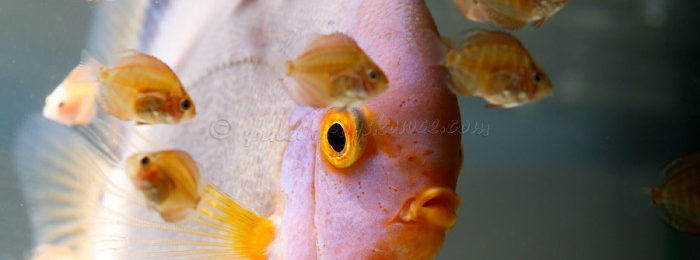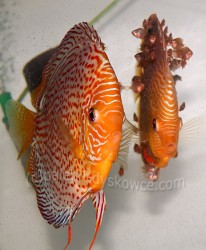Warning: Undefined array key 4364 in /home/platne/serwer18006/public_html/sserpdrow/wp-content/plugins/jetpack/modules/carousel/jetpack-carousel.php on line 888
This post is also available in:
![]() Polski
Polski
I wrote quite a lot about the quality of water for spawning discus, but not much about the lighting of the tank. Recent blog comments have inspired me to write more on this topic. Generally, the lighting of the aquarium during discus spawning does not have any great influence on its course, but then, when the fry melt (about 3 days after hatching of the larvae), it can sometimes decide about the success or failure of the aquarist.
I’ve described the behavior of adult discus fish before, setting themselves up in a wait-and-see attitude that looks like they’re trying to attract tiny discus fish trying their first swimming skills. I will repeat once again that during this time I advise you to refrain from any disturbance of the fish. This is the time that determines how many offspring you can get.
Now we come to the point – what is the effect of aquarium lighting on the results of discus spawning at this time. Well, it can be considered true that the type and intensity of light may not affect the course and efficiency of discus reproduction, but … not in every case. It happens that tiny discus fish starting to swim have a problem with finding their parents, and despite the efforts of adult fish to catch and spit the fry onto their partner, the discus fish fail to keep the fry on themselves. The little fish seem to have a hard time deciding which objects in the tank to consider as parents, and as a result they swarm around the tank instead of just nibbling at the parent pair. As I have also written before, such behavior can be the cause of disease (e.g. flagellate and/or nematode infection) – then there is little that can be done and the only thing that can be done is to deal with the effective treatment of adult fish so that the next spawning can be successful. However, if the fish are healthy and there is a problem with the young discus “entering” the parents, then a simple “light trick” may work. The trick is simply to turn off the aquarium lighting and leave the tank in semi-darkness. In fact, twilight is a natural state of light in the environment of wild discus, and these fish choose secluded and at least shaded places in nature for spawning. The fry that start swimming are calmer in the dark and “climb” on their parents much easier.
Beginner aquarists want to carefully observe discus during spawning and it is understandable, but not everyone can associate the above-mentioned problems with tank lighting. The problem with sticking to the parents may primarily concern fish completely devoid of dark pigment, i.e. many red, yellow, white varieties and derivatives. The way to successfully feed the fry of these discus varieties on the parents of fry has been a kept secret of breeders for years, and it is trivially simple – turn off the light at least for the time from the moment just before the young discus starts swimming to their full acclimatization on the backs of the parents, i.e. about 3~5 days after starting swimming. It is not necessary to darken the room or cover the aquarium with a towel, although some people use such methods as well. One simple rule – provide the fish with semi-darkness. After the mentioned 3-5 days, when the small discus stick well to the backs of their parents, you can turn on the light and it should no longer affect the behavior of the young, although it may happen that it will affect the behavior of adult fish, which may start to show increased aggression towards to each other. If you notice this behavior of adult discus after turning on the light, it is better to turn the light back off.


Search